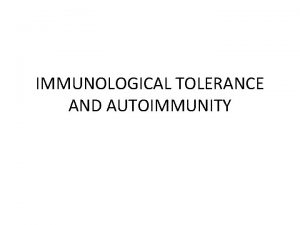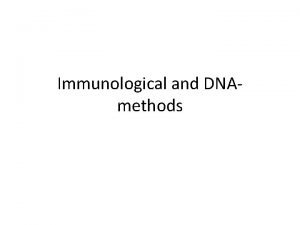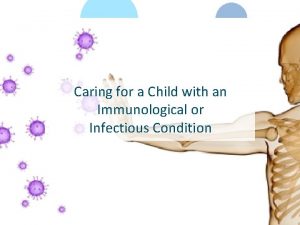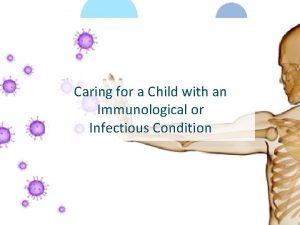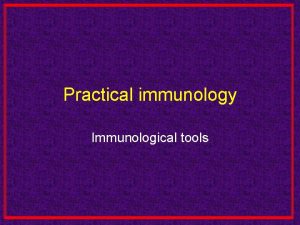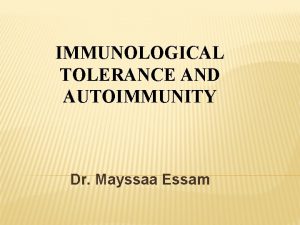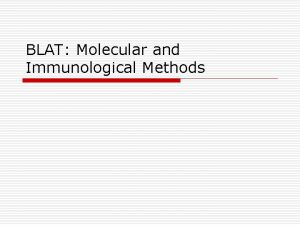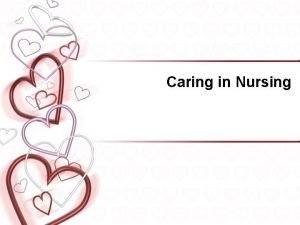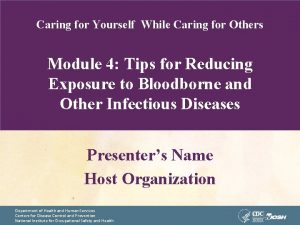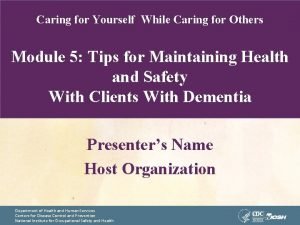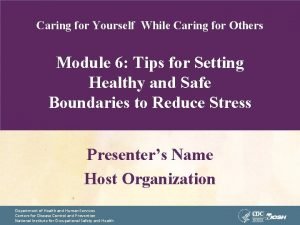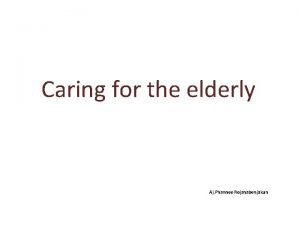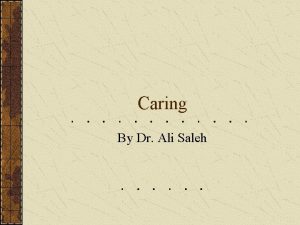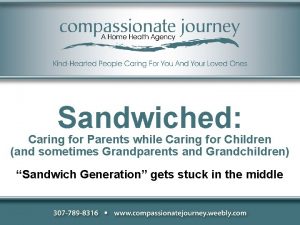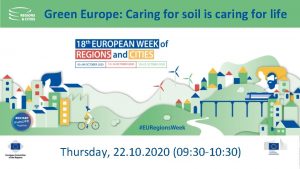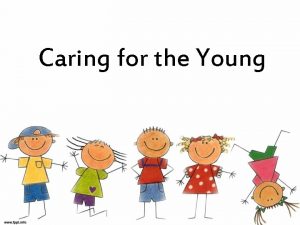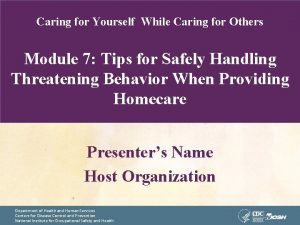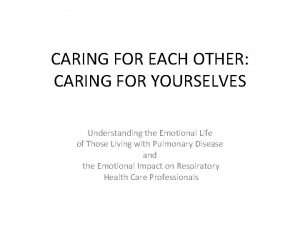Caring for a Child with an Immunological or

































































- Slides: 65

Caring for a Child with an Immunological or Infectious Condition

Anatomy and Physiology Review of the Immune system • We know the goal of national and local governments is to prevent and control communicable diseases and pediatric nurses (or nurses forced to care for children!) assists families to be informed and educated so……they become an advocate for their children. • Immune system is responsible for: • Recognizing antigens • Responding to antigens by producing antibodies to fight them • Remembering antigens so the body can mount a defense if the antigens invade the body again • We will go deeper into the Immune System in NSG 203

Mechanisms of Immunity • Lymph system and spleen • Passively filter plasma for bacteria or foreign material • Phagocytosis • Phagocytic cells (neutrophils and monocytes) demonstrate decreased chemotaxis, reaching adult levels at age 7. • Cellular immunity • Does not cross the placenta, but fetal T cells may become sensitized to antigens that do cross the placenta • Infant B cells do not respond to infection as well as adults’. • Ig. A, Ig. D, Ig. E, and Ig. M do not cross the placenta; they require an antigenic challenge for production.

Anatomy and Physiology Review (cont’d) • Types of immunity • Innate (natural) • General protection from physical barriers of body • Skin • Mucous membranes • Adaptive (active) • Develops as children are exposed to diseases or immunized against diseases through vaccination • Passive • Acquired by introducing pre-formed antibodies into unprotected individual • From mother to fetus through placenta • Newborns can acquire immunity through breastfeeding • Only temporary

Variations in Pediatric Anatomy and Physiology • Healthy full-term infant’s immune system is still immature. • The newborn exhibits decreased inflammatory response to invading organisms, increasing susceptibility to infection. • Cellular immunity is generally functional at birth; humoral immunity develops over time.

Developmental Aspects of the Immune System: Why Are Children Vulnerable? • Children’s skin more susceptible to external irritants with greater risk for microorganism absorption • Skin thinner than that of adults • Children have greater body surface area than adults • Immunoglobulin A (Ig. A), secreted by mucous membranes, does not reach adult levels until child is 5 years of age • Endocrine glands not capable of mature function until 3 years of age, making children less able to regulate body temperature

Primary Immunodeficiencies • Mostly hereditary or congenital • Types • Humoral deficiencies • Cellular immunity deficiencies • Combination of humoral and cellular immunity deficiencies • Phagocytic system defects • Complement deficiencies

Congenital Immunodeficiency Disorders Types of Congenital Disorders • Antibody deficiency: B-cell disorders • Characterized by inadequate immunoglobulins • Do not become apparent until after 3– 6 months (maternal antibodies naturally protect newborns) • Sometimes occur later in childhood or in adulthood • Signs and symptoms • Recurrent infections beginning with respiratory infections, sinus infections, and pneumonia • Sometimes chronic GI malabsorption syndromes and inflammatory bowel disease –like symptoms

Types of Congenital Disorders (cont’d) • Combined deficiency T- and B-cell disorders • Usually manifest before 6 months of age • Signs and symptoms • Failure to thrive • Severe infections, including septicemia and meningitis • Recurrent candidiasis and prolonged diarrhea, which may cause severe diaper dermatitis • Opportunistic infections caused by Pneumocystis jiroveci pneumonia and Toxoplasma gondii

Types of Congenital Disorders (cont’d) • Phagocyte defect disorders • Can occur very early in child’s life • Signs and symptoms • Dermatitis, impetigo, mouth ulcers, pneumonia, suppurative adenitis (infected lymph nodes), abscesses, and osteomyelitis • Wounds do not heal properly

Types of Congenital Disorders (cont’d) • Complement defect disorders • Can manifest at any age in childhood • Signs and symptoms • Severe infections, including meningitis, septicemia, and sinus or pulmonary infections • Associated autoimmune disorders may occur, including systemic lupus erythematosus (SLE), dermatomyositis, and scleroderma

Modell’s 10 Warning Signs of Primary Immunodeficiency • ≥ 8 ear infections per year • ≥ 2 serious sinus infections per year • ≥ 2 months on antibiotics with little effect • ≥ 2 pneumonias within 1 year • Failure of infant to gain weight or grow normally • Recurrent, deep skin or organ abscesses • Persistent thrush in mouth or on skin after age 1 year • Need for IV antibiotics to clear infections • ≥ 2 or more deep seated infections • Family history of primary immunodeficiency

Congenital Immunodeficiency Disorders • Diagnosis • Based on symptoms of congenital immunodeficiency disorders that began in infancy, depending on exact immune components involved • Lab tests include full blood count and immunoglobulin levels (especially Ig. A, Ig. G, and Ig. M) • Additional tests ordered depending on suspected disorder • Laboratory and Diagnostic Testing for HIV Infection • Polymerase chain reaction (PCR) test: positive in infected infants older than 1 month of age • Enzyme-linked immunosorbent assay (ELISA) test: positive in infants of HIV-infected mothers because of transplacentally received antibodies. These antibodies may persist and remain detectable up to 24 months of age, making the ELISA test less accurate at detecting HIV infection in infants and toddlers than the PCR. • Platelet count: above 500, 000 (in severe HIV infection) • CD 4 counts (low in HIV infection)

Congenital Immunodeficiency Disorders • Nursing care • Draw pre- and post-immunization titers for routine immunizations, (e. g. , tetanus, diphtheria, mumps, and rubella) to determine if enough immunity is present to form response to these immunizations • Monitor frequency of infections, lack of response to antibiotic therapies, and development of more severe infections • Education/discharge instructions • Inform family that continued monitoring is needed to assess for failure to thrive or weight-loss patterns • Refer family to support groups and healthcare specialists

Human Immunodeficiency Virus • Maternal HIV infection • The virus selectively targets and destroys T helper cells, destroying cellular immunity • Signs and symptoms • Lymphadenopathy • Hepatosplenomegaly and hepatitis • Chronic diarrhea, with malabsorption • Failure to thrive, Growth failure • Persistent thrush in the mouth, Chronic cough • Recurrent, Skin infections to Recurrent deep skin or organ abscesses including mucous membrane, • Recurrent low-grade fever • Two or more serious infections in early childhood • Extensive eczema

Human Immunodeficiency Virus (cont’d) • Signs and symptoms (cont’d) • Thrombocytopenia • Developmental delay and loss of milestone achievements • Resulting conditions include: • Cardiomyopathy • Nephropathy • ≥ 2 serious sinus infections per year • Diagnosis • Requires multipronged approach using appropriate testing and clinical observation • Separate criteria exist for children < 13 years, as diagnosis can be complicated by transmission of maternal antibodies in infants • For children > 13 years, testing is same as for adults • Enzyme-linked immunosorbent assay (ELISA) identifies presence of HIV antibodies • If the initial ELISA antibody test is positive, it merits repeating • If still positive, Western Blot test, a confirmatory indirect fluorescent antibody test, is performed

Human Immunodeficiency Virus (cont’d) • Goals of treatment: • To slow progression to AIDS • To prevent infections • To promote normal growth and development • To prevent complications, including cancers • To prolong and improve quality of life • Goal of Nursing Care of the Child With HIV Infection • Avoiding infection • Promoting compliance with the medication regimen • Promoting nutrition • Providing pain management and comfort measures • Educating the child and caregivers • Providing ongoing psychosocial support

Stressors Involved With Diagnosis of HIV Infection in Children • Diagnosis of an incurable disease • Financial difficulties • Multiple family members with HIV • HIV-associated stigmas • Desire to keep HIV infection confidential • Multiple medical appointments and hospitalizations

Human Immunodeficiency Virus (cont’d) • Nurses must: • Provide psychological support • Assess family’s support systems, coping mechanisms, and overall ability to care for HIV-infected child • Determine best way to care for both patients if the mother is also infected with HIV • Help family access available resources, including social services, financial aid, spiritual support, insurance coverage, and community health clinics • Initiate coordination of ongoing care by contacting case manager to guide family through complex health-care system • Focus on decreasing the potential for opportunistic infection • Prophylactic antibiotic regimen for P. jiroveci pneumonia (usually Bactrim or Septra) is routine • Intravenous immune globulin (IVIG) has also been used to prevent bacterial infections in young children

Human Immunodeficiency Virus (cont’d) • Education/discharge instructions • Teach family signs and symptoms of infection • Encourage limiting child’s exposure to large crowds of people and those with notable infections • Emphasize proper hygiene, good nutrition, play, rest, and social interaction; all are important aspects of care for the child • Ensure good communication between family and healthcare providers to facilitate realistic ongoing treatment plan • Work closely with adolescents to identify strategies for managing complex medical illness with the need to be independent and socialize with peers • Referral to adolescent support group is often helpful

Systemic Lupus Erythematosus • Multisystem, chronic autoimmune disorder of the blood vessels and connective tissue • Autoantibodies attach to body proteins, creating antigen– antibody complexes; the complexes are deposited throughout the body, causing widespread tissue damage • Signs and symptoms • Symptoms are highly variable in presentation and severity • Fever • Malaise • Chills • Fatigue • Weight loss

Systemic Lupus Erythematosus (cont’d) • Signs and symptoms (cont’d) • As disease progresses, symptoms may include: • Malar photosensitive rash (butterfly rash on the face) • Arthritis • Photosensitivity • Serositis • Proteinuria • Immunological and hematological disorders, such as hemolytic anemia, lymphocytopenia, thrombocytopenia, and vasculitis • Abnormal antinuclear antibody (ANA) titer

Systemic Lupus Erythematosus (cont’d) • Diagnosis • Complete blood cell count with differential • Metabolic chemistry panel • Urinalysis • Antinuclear antibody (ANA) • Negative ANA test excludes SLE diagnosis • Positive ANA test does not definitively indicate SLE; more tests must be added to confirm diagnosis • Anti-DNA antibody • Complement 3 (C 3) and complement 4 (C 4) • Quantitative immunoglobulins • Rapid plasma reagin (RPR) • Lupus anticoagulant • Erythrocyte sedimentation rate (ESR) • Cardioreactive protein (CRP) • Antiphospholipid antibodies

Systemic Lupus Erythematosus (cont’d) • Nursing care • Manage pain and inflammation (NSAIDs in mild cases of SLE) • Treat symptoms of arthritis, rashes, mouth ulcers, fever, and fatigue using antimalarial medications • Prevent complications • Assess patient to ensure prompt recognition of an exacerbation • Check for signs of depression and altered body image in adolescents • Administer oral steroids as prescribed to control disease during exacerbation period • Corticosteroids (prednisone, prednisolone, or Medrol) highly effective in reducing inflammation and symptoms, although immunosuppression is serious side effect • Corticosteroids may be initiated in high doses and tapered after symptoms are under control

Systemic Lupus Erythematosus (cont’d) • Education/discharge instructions • Teach parents • Steroids must be tapered slowly when time to discontinue medication • Children on steroids may be irritable, very energetic, or have insomnia • Keep child away from infectious disease sources, as immunity may be altered • Educate parents on Palliative care and providing psychosocial support Maintaining good nutrition for child (balanced diet, low in salt) Increasing exercise during remissions Increasing rest during exacerbation Communicate to family and patient to avoid excessive sunlight and stress due to the photosensitive rash that occurs with SLE • Encourage expression of feelings/refer child and/or family to support group • Emphasize that parents should notify teachers, coaches, and others about child’s condition • Help child and family identify possible triggers and assist in finding ways to avoid them • • •

Dermatomyositis • Relatively uncommon disorder found in children and adults • Characterized by muscle weakness and a distinctive rash • Signs and symptoms • Proximal muscle weakness, especially in shoulders and pelvis • Heliotropic violaceous (red-purple) rash around eyes and upper eyelids • Possible malar rash similar to that in SLE, with edema of face and eyes • Tenderness, stiffness of muscles, possible voice change, dysphagia

Dermatomyositis (cont’d) • Diagnosis • Made clinically and requires care of rheumatologist • Results of following lab tests may also be abnormal: • Liver function (elevated) • WBC (elevated) • Lymphocyte count (depressed) • Hematocrit (low) • Albumin (low) • Creatine kinase (elevated) • Erythrocyte sedimentation test (elevated) • Further testing includes electromyelography, muscle biopsy, and MRI of quadriceps muscle

Dermatomyositis (cont’d) • Nursing care • Emotional care • This chronic disorder can cause significant physical disabilities and socially embarrassing facial and voice changes • Provide therapeutic listening and support for coping mechanisms • Physical care • Monitor for adverse effects of potent medications used to treat disorder, including long-term steroids and methotrexate (Rheumatrex) • Education/discharge instructions • Teach parents about medications • • • Long-term steroids (up to 2 years’ dosing) Methotrexate (Rheumatrex) Cyclosporine (Sandimmune) Hydroxychloroquine (Plaquenil) Intravenous immunoglobulin (IVIG) when needed

Scleroderma • Chronic autoimmune disease divided into three types: full scleroderma, limited scleroderma, and localized scleroderma • Signs and symptoms • Raynaud’s phenomenon • An intermittent vasospastic disorder in which cold temperatures or stress put the child’s fingers and/or toes into vasospasm • Causes a color change to blue (cyanosis), white (blanching), then red (as the blood flow returns) • Arthralgia • Esophageal dysfunction (difficulty swallowing, gastroesophageal reflux) • Potential renal, pulmonary, and cardiac dysfunction, including pulmonary hypertension • Skin changes can occur with localized scleroderma • Indurated, hypopigmented, or hyperpigmented plaques, called morphea, causing thickened skin, scarring, atrophy, and contractures of underlying joints

Scleroderma (cont’d) • Diagnosis • Based on CREST syndrome • C = calcinosis (bony prominences) • R = Raynaud’s phenomenon • E = esophageal dysmotility (GERD and motility issues) • S = sclerodactyly (stiff skin over hands) • T = telangiectasias (tiny broken capillaries on skin) • ANA and anticentromere antibody are positive in scleroderma • Radiologic tests (e. g. , esophageal motility tests, stress echocardiograms) may be needed to diagnose this disorder

Scleroderma (cont’d) • Nursing care • Provide physical support for symptoms • Provide emotional support for disabilities caused • Pulmonary hypertension associated with marked dyspnea • Renal and cardiac issues • Hardening of skin Assist patients in understanding Raynaud’s phenomenon Dermatologist may follow localized morphea of scleroderma Rheumatologists follow limited and full scleroderma Medications vary based on associated disorders Iloprost (Ventavis) and sildenafil (Viagra) have proven successful for pulmonary hypertension • Calcium channel blockers and topical nitroglycerin may help reduce the vasoconstriction of Raynaud’s phenomenon • • • Education/discharge instructions • Advise parents and children on sports participation due to decreased mobility from hardened patches of skin • Refer to counseling, if needed, for possible disfigurement • Give information on topical or systemic medications, (e. g. , calcipotriene, methotrexate) and potential adverse effects

Anaphylaxis • Considered a medical emergency and the most severe allergic reaction possible; body reacts violently to an antigen (foreign substance), causing a hyperacute allergic response • Fatalities are due to respiratory compromise and cardiovascular collapse, with respiratory failure being more common in pediatric mortality

Anaphylaxis (cont’d) • Signs and symptoms • Wheezing • Tachycardia • Hypotension • Cyanosis • Alteration in level of consciousness • • • Nasal congestion Angioedema (swelling around mouth and oropharynx) Facial edema Anxiety Hives and urticaria Nausea and vomiting Abdominal pain Laryngospasm Sense of impending doom Vascular collapse and cardiac arrest

Anaphylaxis (cont’d) • Diagnosis • Based on • History • Skin-prick allergy testing (contraindicated if the child is anaphylactic to a substance) • Serum allergy testing, such as the radioallergosorbent test (RAST) or Immuno. CAP test • Differentiate true food allergies from cell-mediated food hypersensitivities (e. g. , celiac disease, malabsorption syndromes, and food-induced colitis) • Must differentiate between anaphylaxis and oral allergy syndrome (OAS) • OAS causes tingling of palate, tongue, lips, or oropharynx after ingesting certain foods • True anaphylactic food allergies can be life-threatening with respiratory or cardiac arrest • Some food allergies are only manifested by urticaria and pruritus

Anaphylaxis: Nursing Care • Immediate nursing care includes the following actions: Activate the emergency system and perform cardiopulmonary resuscitation Ensure adequate airway: endotracheal intubation or Administer oxygen Administer epinephrine (adrenaline) Place a tourniquet proximal to site of injection or insect sting Keep child lying flat with feet slightly elevated; keep warm Administer corticosteroids and antihistamines Determine cause of attack Support of airway, breathing, and circulation (CABs) Initiation of intravenous (IV) therapy with an isotonic crystalloid solution ASAP Epinephrine (adrenaline) injection is administered intramuscularly or intravenously to provide reversal of pulmonary bronchospasm and constriction of blood vessels, thereby improving respiratory status and blood pressure • Provide ongoing assessment for shock, which can be treated via IV fluid bolus • Antihistamines and corticosteroids may be added to further control symptoms after initial stabilization • • • Provide follow-up care to prevent recurrences • If allergies cannot be completely eliminated, refer to allergist for desensitization treatments or self-administration epinephrine prescription

Anaphylaxis (cont’d) • Education/discharge instructions • Teach parents to recognize early indicators of anaphylaxis and to act quickly on these indicators • Instruct the parent to administer the medication exactly as directed and call 911 immediately in event of emergency • Instruct the parents to teach the child to know his or her triggers • Review correct administration technique for the Epi. Pen or Epi. Pen Jr (epinephrine) • Teach child to self-inject epinephrine medication and what to do in case of emergency • If child is too young to self-inject, tell parents to discuss allergy and how auto-injector works with the child’s caregiver or another responsible adult, when the child is not with the parents

Types of Infection • Viral • Microorganisms are smaller than bacteria • Do not grow without having living cell as host • Replicate themselves in other living cells of people, animals, or plants • Limited antiviral antibiotics available for some types of viruses • Fungal • Pathological organisms • Most likely in children with compromised immune system • Antifungal agents used to treat fungal infections • Bacterial • Single-celled living microorganisms • Found everywhere in environment • Antibacterial antibiotics treat bacterial infections

Infections • Signs and symptoms • Fever • Malaise • Anorexia • Pruritus (itching) from rashes • Diagnosis • Confirmed by type of infection, signs and symptoms, and various diagnostic means, such as: Complete blood count (CBC) with differential Urinalysis (UA) Spinal fluid analysis Cultures from fluids, secretions, drainage (including blood, urine, sputum, nasal fluids, and wounds) • Chest radiograph • Computerized tomography (CT) • •

Infections (cont’d) • Nursing care • Promote immune function • Promote good skin care • Optimize nutrition • Help maintain natural body barriers to disease and natural immune response • Assess accurately • Prevent disease transmission • Treat signs and symptoms • Education/discharge instructions • Teach families about universal precautions • Hand washing • Cleaning of toys and surfaces • Proper diaper disposal • Teach how to prevent complications • Emphasize importance of excluding the child from school and other activities during the illness

Fifth’s Disease (Erythema infectiosum) • Caused by human parvovirus B 19 • Signs and symptoms • Begins with facial red rash, appearing as though the cheeks were slapped • Rash spreads to trunk and extremities, appearing more as macular (flat), lacy-appearing erythematous exanthema (rash) • Fever may occur • Although usually gone in a week, rash can recur with heat exposure for ≤ 4 months • Diagnosis • Made through clinical appearance of signs and symptoms • Can be accurately diagnosed with Ig. M parvovirus B 19 antibodies in serum within 30 days of rash onset

Fifth’s Disease (cont’d) • Nursing care • Keep child away from pregnant women • Use acetaminophen or ibuprofen for symptoms that may accompany disease: • High fever • Sore throat • Headache • Droplet precautions should be instituted if child is hospitalized • Education/discharge instructions • Instruct patient and family to maintain safe hygiene practices • Emphasize keeping child away from potentially pregnant women • Do not use aspirin-containing products because of risk of Reye’s syndrome

Cytomegalovirus • Member of the herpes family; attaches to host cells to cause disease • Signs and symptoms • Babies born with CMV • Some asymptomatic • Some experience hearing loss, neurological issues, intrauterine growth retardation • Older children may experience symptoms similar to infectious mononucleosis: • Fever • Headache • Older children may experience symptoms similar to infectious mononucleosis (cont’d): • Rash • Abdominal pain • Hepatitis • CMV can also cause pneumonia and self-limited GI symptoms • Retinitis can cause blindness in CMV infection associated with AIDS • CMV hepatitis can occur in transplanted livers

Cytomegalovirus (cont’d) • Diagnosis • Urine, saliva, blood, and biopsy samples can be used for virus isolation to make a diagnosis • CMV pneumonia suggested by radiograph, lung CT scan • Nursing care • Note if patient has any signs of immune deficiency, which may have put patient at risk for CMV: • • Frequent sore throats Respiratory infections Enlarged lymph nodes Recurrent fevers • Evaluate need for acetaminophen or ibuprofen for symptom control • Monitor patient for • • Vision changes Weight loss Anorexia Nausea Vomiting Shortness of breath Chest tightness Fever

Cytomegalovirus (cont’d) • Education/discharge instructions • Educate about: • Risks of disease and treatments • Risk to pregnant or potentially pregnant women • Importance of universal precautions (e. g. , hand washing) • Teach parent how to handle diapers or underclothing carefully • Patient with CMV and concurrent HIV/AIDS will require optometry evaluations of optic fundus

Herpes Simplex Virus • Extremely common virus • Two types: herpes simplex 1 (HSV-1) and herpes simplex 2 (HSV-2) • Type 1 is primarily associated with mouth, lip, and facial lesions • Type 2 is primarily associated with genital lesions and neonatal cases (through birth to an infected mother) • Signs and symptoms • Small vesicles on erythematous base usually form around: • Lips and/or base of nose • Genital area • Vesicles crust over as they heal • Prodrome of pruritus or burning is often present before lesions develop • Lesions are painful when vesicles break and skin is opened up • Diagnosis • Obtained through culture of fluid from vesicles • Type HSV as either 1 or 2 • Spinal fluid, Pap smears, and Tzanck prep tests also diagnostic

• Nursing care Herpes Simplex Virus (cont’d) • For children with facial HSV-1, administer topical prescription antiviral medications (acyclovir or penciclovir ointments) as prescribed • For children with HSV-2, there may be concerns about inappropriate sexual exposure • May administer IV, topical, or oral antiviral agents • Acyclovir (Zovirax) for younger patients • IV acyclovir is standard treatment for disseminated newborn infections • Famcyclovir (Famvir) and valacyclovir (Valtrex) for older adolescents and adults for acute episodes • Careful hand washing and contact precautions (including avoiding kissing and touching, use of gloves) are necessary • Report any facial lesions that are tracking up face, cheek, or nose close to eyes, as ocular herpes can cause blindness if not treated immediately • Education/discharge instructions • • • Teach parents to use separate towels and drinking glasses for infected children Remind parents and patients that herpes simplex is usually recurrent Educate on avoiding shared toothbrushes and lip cosmetics Tell patients to avoid excessive sunlight Recommend latex condoms for patients who are sexually active It is not known if herpes can be spread when there are no active lesions

Herpes Zoster (Shingles) • Caused by same virus that causes chickenpox; on first exposure to virus, child contracts chickenpox; on subsequent exposure, virus is reactivated and herpes zoster occurs • Signs and symptoms • Cutaneous vesicular lesions that follow the nerve pattern on face, trunk, and upper back • Usually on only one side of the body • Like herpes simplex lesions, but clustered in larger numbers and more painful • Classic presentation = “dew drops on a red rose” (clear fluid-filled vesicle on erythematous base) • Prodrome of burning pain or pruritus may occur before lesions • Pain from nerve involvement

Herpes Zoster (cont’d) • Diagnosis • Based on patient history and physical examination findings • Important to obtain any history of chickenpox • Nursing care • • Hospitalize patients with disseminated herpes zoster infections Observe patients for meningitis, encephalitis, deafness, and uveitis Most patients can be taken care of at home Decrease itching and pain using: • Cool water compresses • Cool baths • Decrease itching and pain using (cont’d): • Wet-to-dry Burow’s solution dressings, 3 times/day • Calamine lotion • Acetaminophen for pain • Acyclovir (Zovirax) is treatment of choice for children • Can be given by IV for fastest relief for disseminated herpes • May be given orally for recurrent episodes (depending on age)

Herpes Zoster (cont’d) • Education/discharge instructions • Educate on postherpetic neuralgia • Neurologic pain with possible burning sensation • Early use of antiviral medications (e. g. , acyclovir) will decrease chance of postherpetic neuralgia • Continuing pain needs to be reported to health-care providers, as some medications can improve neuralgia • Emphasize that patients should stay away from anyone who has not had chickenpox or been immunized against it • Recurrence of herpes zoster necessitates medical evaluation for underlying disease or immune suppression • Tell patients to avoid directly touching the lesions or exposing another’s skin and mucous membranes to lesions

Infectious Mononucleosis • Epstein–Barr virus responsible for infectious mononucleosis • Historically, infectious mononucleosis was first discovered as a disease that was transmitted through kissing • Although it can occur at any age, the disease is most commonly found in adolescents and young adults • Signs and symptoms • Swollen, enlarged, and tender lymph nodes (cervical, often occipital) • Tonsillitis or pharyngitis with significant exudate • Chills • Fever (103. 3ºF [39. 6ºC]) • Headache • Anorexia • Malaise • Spleen may become enlarged initially • Mononucleosis hepatitis is also possible in severe cases

Infectious Mononucleosis (cont’d) • Diagnosis • Positive monospot test or heterophile result confirmatory • Monospot test may be negative early in disease • CBC and differential may be useful; sometimes increase in monocytes seen on differential cells early in disease • Blood test can be drawn to confirm the presence of Epstein–Barr virus • Nursing care • Communicate to parents the importance of: • • • Bedrest Maintaining hydration Decreasing fever Isolating patient during acute phase Continuing to include rest periods after acute phase Removing child from contact sports that could injure liver or spleen • Discourage: • Sharing drinking cups/utensils with family members and peers • Close contact, such as kissing • Education/discharge instructions • Educate about: • • Risk of spleen rupture Possibility of relapse with worsening symptoms Avoiding acetaminophen due to greater risk of hepatotoxicity when liver is enlarged Avoiding alcohol due to risk of hepatomegaly

Fungal Infections • Histoplasmosis • Occurs when inhaled mold spores convert to yeast in lungs • High-risk areas of mold include cleaning or excavating in old homes or schools, cutting firewood, gardening, exploring barns and caves • Signs and symptoms • • Weight loss Fever Fatigue Dry cough and substernal chest pain Acute respiratory distress syndrome Meningitis in infants Pericarditis and arthritis symptoms. Medical management for histoplasmosis includes amphotericin B (Amphocin)

Fungal Infections • Coccidioidomycosis • Occurs from inhaling spore-forming molds from soil into lungs • Common in the southwestern U. S. • Asymptomatic or self-limiting without treatment in most patients • Signs and symptoms • • Fever Malaise Respiratory distress Rash of erythema nodosum or erythema multiforme • Signs and symptoms (cont’d) • • Weight loss Arthralgia Headache Confusion • Medical management with azole-type antifungal medications, such as itraconazole (Sporanox)

Fungal Infections • Pneumocystis jiroveci pneumonia • Typically causes pneumonia • Risk higher among immunocompromised pediatric patients and children with HIV • Signs and symptoms • • • Nonproductive cough • Weight loss • Fever • Chills • Dyspnea • Respiratory failure • Tachypnea • Crackles and rhonchi in lungs Prophylaxis commonly managed with trimethoprim-sulfamethoxazole (TMP-SMZ) (Bactrim or Septra) For severe cases: parenteral pentamidine (Nebupent), atovaquone (Mepron), dapsone (Dapsone) and clindamycin (Cleocin) plus primaquine (Phosphate Tablets) Short courses of steroid therapy sometimes used Immunocompromised patients without HIV should also receive Pneumocystis jiroveci pneumonia prophylaxis

• Streptococcus pneumoniae (pneumococcus) • Major cause of pneumonia • Responsible for pediatric otitis media and sinusitis • Haemophilus influenzae Bacterial Infections • Gram-negative, coccobacillus bacterium • Responsible for cases of pediatric otitis media and sinusitis • Moraxella catarrhalis • A cause of pediatric otitis media and sinusitis • Group A β-hemolytic streptococcus (S. pyogenes, or GAS) • Gram-positive bacterium • Responsible for classic “strep throat, ” rheumatic fever, and rheumatic heart disease • Also seen in a variety of other pediatric disorders • Neisseria meningitidis (meningococcus) • Serious pathogen in development of bacterial meningitis • Sequelae of meningitis include neurological issues and hearing deficits • • • High fever Extremely stiff neck (nuchal rigidity) Vomiting Headache Later development of stellate rash (i. e. , resembling stars) Rapid treatment required • Bacterial meningitis more severe than viral meningitis

Rabies • Acute viral infection of the nervous system caused by Rhabdoviridae lyssavirus, usually transmitted through a bite from an infected wild, carnivorous animal • Signs and symptoms • Early symptoms include nonspecific conditions, such as: • Headache • Fever • General weakness • Later symptoms: • Anxiety • Insomnia • Confusion • • • Paralysis Hallucinations Agitation Hypersalivation Difficulty swallowing • Respiratory tract is then affected • Spasms cause severe impairment of respiratory function • Respiratory arrest

• Diagnosis • Tests are performed on samples of saliva, serum, spinal fluid, and skin biopsies of hair follicles at the nape of the neck for rabies antigen • Human saliva can also be tested by polymerase chain reaction (RT-PCR), and serum and spinal fluid may be tested for antibodies to rabies virus • Prevention • Rabies prevention is two-fold: • All domestic animals that can receive rabies vaccinations should receive them at the appropriate ages and intervals. • All people, and children in particular, should be taught to stay away from wild animals that may carry rabies • Nursing care • • Cleanse the wound with a virucidal agent Administer human rabies immune globulin (HRIG) and the rabies vaccine series Instruct the patient and family regarding follow-up Provide support to the family as needed • Education/discharge instructions • Owing to the traumatic nature of treatment after exposure, seriousness of rabies, and poor prognosis, exercising caution with unknown animals is essential • Most exposures to rabies occur through bites of wild animals, which allow contaminated saliva to enter the bite wound • If an animal has injured a child, the parents must contact their health-care provider immediately

West Nile Virus • Infection spread by mosquitoes bitten by infected birds • In rare cases, the virus can lead to encephalitis, meningitis, myocarditis, and hepatitis • Signs and symptoms • • Fever Weakness Headache Myalgia Anorexia Nausea Vomiting • Diagnosis • Confirmed by specific Ig. M antibody in serum or CSF • Serial cultures are needed to watch changes during acute and convalescent samples • Nursing care • Treat symptoms, as most infected patients recover without incident • Nearly 1: 150 people infected may develop severe symptoms that last several weeks • Headache • High fever • Neck stiffness

• Nursing care (cont’d) • Nearly 1: 150 people infected may develop severe symptoms that last several weeks (cont’d) • Disorientation • Paralysis • Tremor • Numbness • Seizures • Vision loss • Muscle weakness • Coma • Severe symptoms require hospitalization, IV fluids, and respiratory and neurological support • Severe sequelae include meningitis and encephalitis, with risk of permanent neurological defects • Evaluate infants born from infected women for congenital defects West Nile Virus (cont’d) • Education/discharge instructions • Risks of West Nile virus • Preventive care • How to observe for worsening symptoms • Help parents plan strategies for: • Minimizing exposure to mosquito bites • Advise parents to keep children dressed in long-sleeved shirts and pants during peak season • Use mosquito nets for baby carriers • Minimizing possible side effects related to systemic absorption of insect repellents • DEET-containing insect repellents are most effective but can be neurotoxic • Numerous organic and nontoxic natural insect repellents are available

Avian Flu • Avian influenza, or “bird flu, ” refers to an influenza virus that occurs naturally in birds worldwide • Although occurring chiefly in infected poultry, certain subtypes of the virus may mutate and transfer to humans • Signs and symptoms • • • Cough Sore throat Fever Myalgia Nausea • • • Diarrhea Vomiting Abdominal pain Altered mental status Seizures leading to death • Diagnosis • Requires an early viral swab from the throat or nose to be sent to lab for culture or molecular testing • Lower respiratory tract specimens can be analyzed for the critically ill • Serum tests for antibody levels done at two different times may suggest avian flu

Swine Flu (H 1 N 1 Variant) • Swine flu is most often seen in people who work with pigs, and notable risks for children include petting zoos, fairs, and raising pigs for show or clubs • Signs and symptoms • • • Cough Rhinorrhea Possible diarrhea Possible vomiting Fever and chills Fatigue and malaise Arthralgias, myalgias Sore throat In children other conditions may arise: • Neurological symptoms: seizures, mental status changes • Reye’s syndrome risk if aspirin taken with flu • Death • Diagnosis • Rapid flu tests available, but results not always accurate • Flu swab should be taken from nasopharyngeal test • Accuracy depends on test quality, sample collection method, and how much virus is being shed at time of test • Sometimes diagnosis is made solely on basis of clinical symptoms, especially during flu epidemics

Avian and Swine Flu • Nursing care • Provide supportive and symptomatic care • • • Aggressive treatment of complications, such as pneumonia Influenza medications may be used: osteltamivir (Tamiflu) and zanamivir (Relenza) DO NOT administer aspirin to any patients with influenza Acetaminophen is generally safe to use for fever control, headache, and arthralgias Encourage drinking liquids and eating foods as tolerated • DO NOT allow children with influenza in day-care or school settings until they are fully recovered • Observe for risk of serious sequelae • Neurological issues • Respiratory issues

Avian and Swine Flu (cont’d) • Education/discharge instructions • Educate about risks of influenza • Inform about highest-risk populations, who should be vaccinated yearly • Children < 5 years, but especially < 2 years old • Pregnant women • Adults > 65 years • Native Americans and Alaskan natives • Children and adults with chronic medical conditions • Children and teens < 19 years on long-term aspirin therapy (because of Reye’s syndrome) • People on long-term steroid therapy • Provide medication instructions: • Zanamivir (Relenza) for patients ≥ 5 years • Oseltamivir (Tamiflu) for patients ≥ 2 weeks

Zika Virus • Zika is spread mostly by the bite of an infected Aedes species mosquito (Ae. aegypti and Ae. albopictus). These mosquitoes are aggressive daytime biters. They can also bite at night. • Zika can be passed from a pregnant woman to her fetus. Infection during pregnancy can cause certain birth defects. • Zika is not currently being spread by mosquitoes in the continental United States. The mosquitoes that can carry Zika are found in some areas of the U. S. • There is no vaccine or medicine for Zika. • Signs and Symptoms • Many people infected with Zika virus won’t have symptoms or will only have mild symptoms. The most common symptoms of Zika are (Symptoms can last for several days to a week). • • Fever Rash Joint pain Conjunctivitis (red eyes) Other symptoms include: Muscle pain Headache

ZIKA Virus Nursing Assessment/Clinical Intervention • Assess any recent overseas travel of prenatal patients during or within two weeks of travel • Since there are no antiviral treatments for the virus, supportive care should be given for any symptoms such as rest, antipyretics, pain management, and fluids. • Patient Education • Pregnant patients or patients who want to get pregnant to avoid visiting countries with high incidence of Zika virus • If a patient must travel, teach them how to avoid getting mosquito bites such as using bed nets, window and door screens, staying in air-conditioned rooms and not exposing skin • If the patient thinks that they have the virus and feels sick, they should contact their provider and continue using repellent and protective clothing to avoid transmission of the virus to another person. • Nursing interventions should also include thorough travel assessment, education, and provision of comfort measures, safety and pain management. The nurses should make every effort to use available resources to deliver and incorporate bereavement support to the patients and their families.
 Immunological tolerance
Immunological tolerance Immunological methods
Immunological methods Actual caring occasion
Actual caring occasion 패자트리
패자트리 Dikt på rim
Dikt på rim Ledarskapsteorier
Ledarskapsteorier Svenskt ramverk för digital samverkan
Svenskt ramverk för digital samverkan Kvinnlig mantel i antikens rom
Kvinnlig mantel i antikens rom Rita perspektiv
Rita perspektiv Vilken grundregel finns det för tronföljden i sverige?
Vilken grundregel finns det för tronföljden i sverige? Jätte råtta
Jätte råtta Förklara densitet för barn
Förklara densitet för barn Ministerstyre för och nackdelar
Ministerstyre för och nackdelar Sju principer för tillitsbaserad styrning
Sju principer för tillitsbaserad styrning Kanaans land
Kanaans land Tack för att ni lyssnade bild
Tack för att ni lyssnade bild Nyckelkompetenser för livslångt lärande
Nyckelkompetenser för livslångt lärande Sju för caesar
Sju för caesar Mästar lärling modellen
Mästar lärling modellen Matematisk modellering eksempel
Matematisk modellering eksempel Cks
Cks Personalliggare bygg undantag
Personalliggare bygg undantag Verktyg för automatisering av utbetalningar
Verktyg för automatisering av utbetalningar Vishnuismen
Vishnuismen Kyssande vind analys
Kyssande vind analys Exspektans eller expektans
Exspektans eller expektans Tack för att ni lyssnade bild
Tack för att ni lyssnade bild Strategi för svensk viltförvaltning
Strategi för svensk viltförvaltning Fr formel
Fr formel Verksamhetsanalys exempel
Verksamhetsanalys exempel Tack för att ni har lyssnat
Tack för att ni har lyssnat Datorkunskap för nybörjare
Datorkunskap för nybörjare Läkarutlåtande för livränta
Läkarutlåtande för livränta Treserva lathund
Treserva lathund Returpilarna
Returpilarna Inköpsprocessen steg för steg
Inköpsprocessen steg för steg Påbyggnader för flakfordon
Påbyggnader för flakfordon Tack för att ni lyssnade
Tack för att ni lyssnade Egg för emanuel
Egg för emanuel Atmosfr
Atmosfr Personlig tidbok fylla i
Personlig tidbok fylla i Rutin för avvikelsehantering
Rutin för avvikelsehantering Mitos steg
Mitos steg Presentera för publik crossboss
Presentera för publik crossboss Fspos
Fspos Myndigheten för delaktighet
Myndigheten för delaktighet Tes debattartikel
Tes debattartikel Kung som dog 1611
Kung som dog 1611 Tack för att ni har lyssnat
Tack för att ni har lyssnat Tobinskatten för och nackdelar
Tobinskatten för och nackdelar Referatmarkering
Referatmarkering Varför kallas perioden 1918-1939 för mellankrigstiden
Varför kallas perioden 1918-1939 för mellankrigstiden Programskede byggprocessen
Programskede byggprocessen Start för skala
Start för skala Mjälthilus
Mjälthilus Mindre än tecken
Mindre än tecken Rådet för byggkompetens
Rådet för byggkompetens Kraft per area
Kraft per area Elektronik för barn
Elektronik för barn Borra hål för knoppar
Borra hål för knoppar Bris för vuxna
Bris för vuxna A gastrica
A gastrica Smärtskolan kunskap för livet
Smärtskolan kunskap för livet Frgar
Frgar Argument för teckenspråk som minoritetsspråk
Argument för teckenspråk som minoritetsspråk Typiska drag för en novell
Typiska drag för en novell
